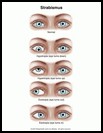
Strabismus
What is strabismus?
Strabismus is a condition in which the eyes point in different directions. Usually one eye is pointed straight ahead and the other is pointed in, out, up, or down.
With normal vision, both eyes are aimed at the same target and the brain blends the 2 similar pictures into one clear, three-dimensional picture (called binocular vision). With strabismus, 2 different pictures are sent to the brain. In a young child, the brain starts to ignore the picture from one of the eyes, and the child loses vision in this eye. This loss of vision is called amblyopia, or lazy eye.
People who develop strabismus as adults often have double vision because the brain is used to processing 2 pictures and cannot easily ignore the picture from the turned eye.
Some types of strabismus are:
- Esotropia or "crossed eye": an eye turns in.
- Exotropia or "wall-eye": an eye turns out.
- Hypertropia: an eye turns up.
- Hypotropia: an eye turns down.
How does it occur?
Strabismus happens when the eye muscles are not balanced. The movements of the muscles of one eye do not match those of the other eye. Sometimes the cause of eye muscle imbalance is not known. Children may be born without the ability to move the eyes together. Children with cerebral palsy or Down syndrome often develop strabismus.
Strabismus in adults may be caused by:
- strabismus from childhood that comes back
- poor vision in one eye, which causes the eye to begin to drift outward
- an injury to the brain or a disease in the brain
- damage to nerves that control eye muscle movement. (This can be caused by a disease such as high blood pressure or diabetes.)
- thyroid disease, which can cause the eye muscles to swell
- myasthenia gravis, which can cause temporary weakness of the eye muscles
What are the symptoms?
The eyes appear to be looking in different directions all or part of the time. In some cases, it may happen only if you are tired or sick. Other symptoms include turning or tilting the head or squinting one or both eyes.
The eyes of babies younger than 3 months old may appear to look in different directions for a few moments, often just before going to sleep. This does not always mean they have strabismus. If a baby's eyes look misaligned constantly by the time they are 2 months old or misaligned part of the time by the age of 3 months, take your baby to an ophthalmologist (medical eye doctor).
How is it diagnosed?
The doctor will do several tests. He may hold a small light in front of the baby's eyes to check if the reflection of this light is properly centered in each eye. In another test, the provider covers one of the child's eyes and then the other to see if the eyes shift abnormally when focusing on a near or distant object.
The provider will test the vision and ability to follow objects with each eye. In older children or adults, the provider will test if the eyes can work well together by checking for three-dimensional vision. He or she will also examine the eyes for any signs of disease.
How is it treated?
The goals of treatment for strabismus are to:
- correct any vision problems
- straighten the eyes and restore the ability to make normal eye contact
- restore the ability for the eyes to work together
Children who have strabismus need to be treated as soon as possible by an eye care provider so they can develop normal vision. Treatment that begins after the age of 6 years may improve a child's appearance but does not always help vision problems.
Treatment of strabismus includes:
- Patching or using special eyedrops in the good eye: This treatment forces the brain to pay attention to the weak eye. Then it works harder and develops more normally.
- Glasses: Glasses are used to correct farsightedness or to improve the focus of the eyes. Farsighted children have to work harder to focus their eyes. This can cause the eyes to cross. Glasses that correct the farsightedness help keep the eyes from crossing.
- Eye exercises: These exercises train the eyes to move together and focus on the same object at the same time. Most forms of strabismus do not improve with eye exercises.
- Surgery on the eye muscles: Muscles may be loosened, tightened, or repositioned. If this surgery is done early enough in some children, they may develop normal vision. Strabismus surgery is not cosmetic surgery. Having eyes that are not aligned normally interferes with a person's ability to communicate with others through eye contact. Most insurance plans will pay for this surgery.
More than one surgery may be needed. The success of surgery depends partly on the coordination between the eyes and brain. It needs to be good enough to keep the eyes locked on target and in alignment.
Prism glasses may be prescribed for adults. Wearing these glasses can sometimes help double vision.
How can I take care of myself or my child?
All adults and children should have eye exams regularly. Tell your provider about any eye misalignment you notice in yourself or in family members. If your eye care provider recommends patching or any other treatment, follow your provider's instructions exactly.

